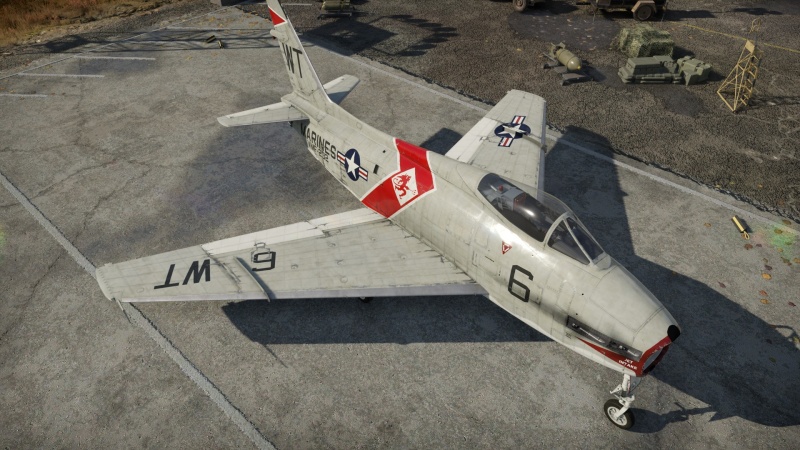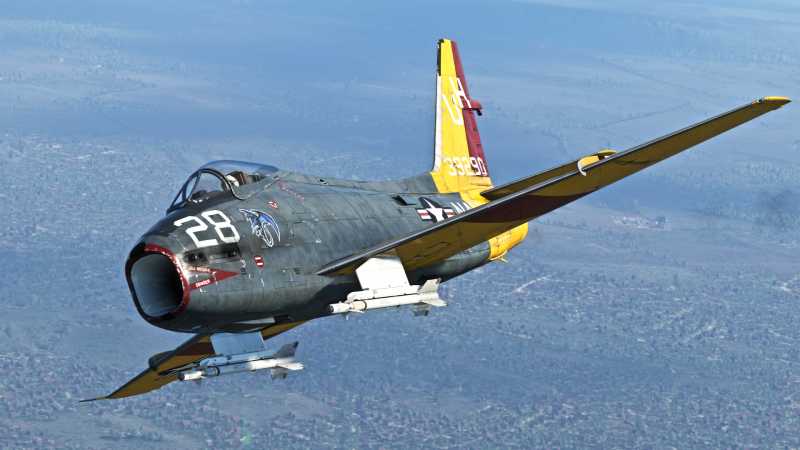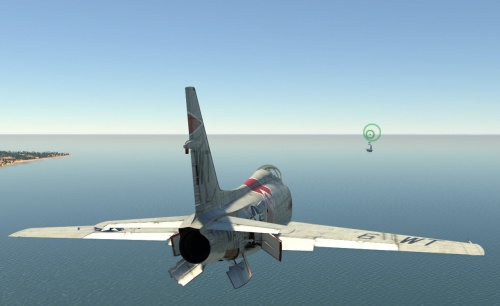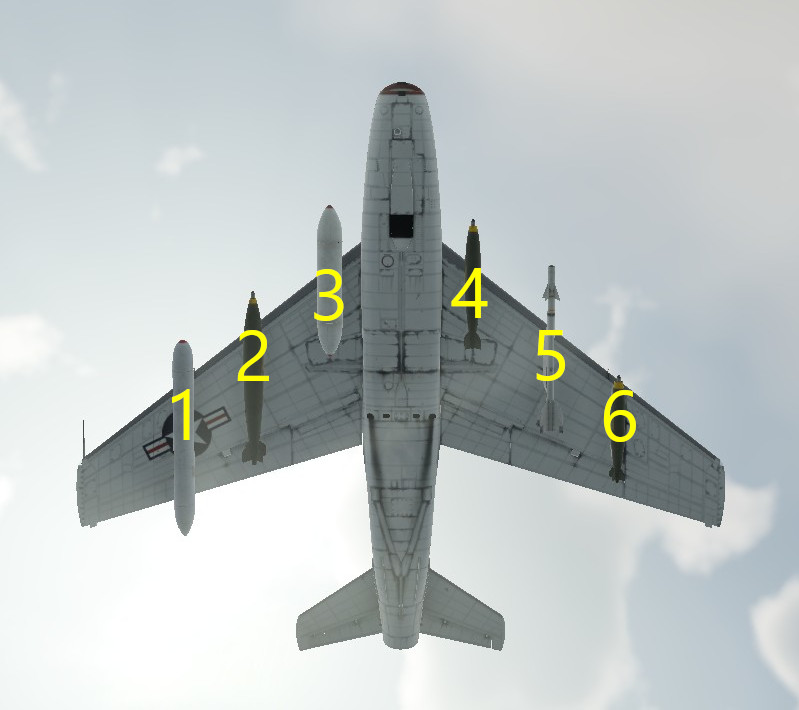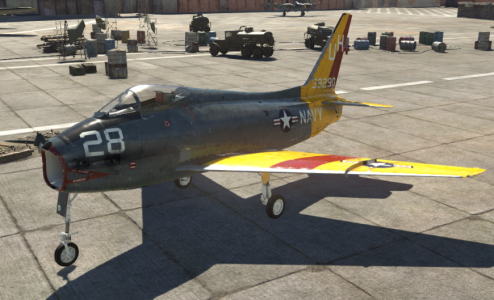FJ-4B VMF-232
| This page is about the gift American strike aircraft FJ-4B VMF-232. For the regular version, see FJ-4B. For other versions, see F-86 (Family). |
Contents
Description
The VMF-232 squadron of the Marine Corps, nicknamed "Red Devils", was known for using the FJ-4B in the 1950s, specifically between 1956 and 1959, after gathering experience with the FJ-2 and FJ-3. The squadron and their FJ-4Bs were deployed on USS Bennington during the Quemoy Matsu Crisis in 1958, and later transferred to Naval Air Facility Atsugi. In 1958, the squadron flew more than 10,000 hours. After their deployment ended, VMF-232's FJ-4Bs started to be replaced by the introduction of the first batch of F-8 Crusaders.
It was introduced in Update 1.79 "Project X" as the main reward for the Good Old S.U.M.M.E.R event 2018. The FJ-4B VMF-232 is a solid multi-role US Marine aircraft which can fight air-to-air combat, ground-pound, or both. The fighter features four 20 mm autocannons and then can outfit several different ordnance to its underwing stores. Bomb load-outs range from using 250, 500, 1,000 or 2,000 lb bombs effectively targeting from vehicles and pillboxes all the way up to bases. FFAR Mighty Mouse rockets make short work of ground targets, but also can be deadly against any of the bomber aircraft it may intercept. Bullpup rockets can create a huge punch into a ground target, however, it requires the attention of the pilot all the way to the target to ensure it hits. The FJ-4B VMF-232 can also sport four AIM-9B Sidewinder missiles, which any smart pilot on the receiving end will immediately begin evasive manoeuvres when one of these are inbound because, at that point, nothing else matters!
General info
Flight performance
The FJ-4B's flight performance is a bit sluggish. Due to the weight of the airframe, it has poor acceleration compared to other aircraft at 9.0. The FJ-4B is not a very fast aircraft, at most you will see 880 km/h at sea level. It is not recommended to climb vertically in this aircraft, what is recommended is to build up speed at sea level then zoom climb up to your desired altitude.
| Characteristics | Max Speed (km/h at 152 m) |
Max altitude (metres) |
Turn time (seconds) |
Rate of climb (metres/second) |
Take-off run (metres) | |||
|---|---|---|---|---|---|---|---|---|
| AB | RB | AB | RB | AB | RB | |||
| Stock | 1,058 | 1,029 | 32.5 | 33.2 | 28.1 | 26.4 | 750 | |
| Upgraded | 1,107 | 1,090 | 30.2 | 31.0 | 42.8 | 35.0 | ||
Details
| Features | |||||
|---|---|---|---|---|---|
| Combat flaps | Take-off flaps | Landing flaps | Air brakes | Arrestor gear | Drogue chute |
| ✓ | ✓ | ✓ | ✓ | ✓ | X |
| Limits | ||||||
|---|---|---|---|---|---|---|
| Wings (km/h) | Gear (km/h) | Flaps (km/h) | Max Static G | |||
| Combat | Take-off | Landing | + | - | ||
| 600 | 575 | 435 | ~10 | ~4 | ||
| Optimal velocities (km/h) | |||
|---|---|---|---|
| Ailerons | Rudder | Elevators | Radiator |
| < 750 | < 690 | < 680 | N/A |
Engine performance
| Engine | Aircraft mass | |||||||
|---|---|---|---|---|---|---|---|---|
| Engine name | Number | Basic mass | Wing loading (full fuel) | |||||
| Wright J65-W-16A | 1 | 6,799 kg | 299 kg/m2 | |||||
| Engine characteristics | Mass with fuel (no weapons load) | Max Takeoff Weight | ||||||
| Weight (each) | Type | 15m fuel | 20m fuel | 30m fuel | 45m fuel | 50m fuel | ||
| 1,270 kg | Axial-flow turbojet | 7,576 kg | 7,831 kg | 8,346 kg | 9,120 kg | 9,389 kg | 12,700 kg | |
| Maximum engine thrust @ 0 m (RB/SB) | Thrust to weight ratio @ 0 m (100%) | |||||||
| Condition | 100% | WEP | 15m fuel | 20m fuel | 30m fuel | 45m fuel | 50m fuel | MTOW |
| Stationary | 3,410 kgf | N/A | 0.45 | 0.44 | 0.41 | 0.37 | 0.36 | 0.27 |
| Optimal | 3,410 kgf (0 km/h) |
N/A | 0.45 | 0.44 | 0.41 | 0.37 | 0.36 | 0.27 |
Survivability and armour
- 60 mm Bulletproof glass in front of the pilot.
- 12.7 mm Steel plate behind the pilot.
The FJ-4B VMF-232 fighter has minimal armour to save weight, which allowed for more fuel tanks to be installed. The armour on the aircraft is limited to a 12.7 mm steel plate behind the pilot's seat and a 60 mm bulletproof glass in the windscreen of the aircraft. This armour protection at best will help the pilot survive a pilot snipe, however, it will not do anything to protect the fuel tanks and jet engine which are all vulnerable to gun, rocket and missile fire.
Modifications and economy
Armaments
Offensive armament
The FJ-4B VMF-232 is armed with:
- 4 x 20 mm Browning-Colt Mk12 Mod 3 cannons, nose-mounted (144 rpg = 576 total)
Like many of the contemporary fighters of the time, the FJ-4B VMF-232 was considered a gunslinger fighter. Fighter aircraft were flying much faster than aircraft a few years earlier and needed to have more manoeuvrability than ever before, one way to do this was to remove the guns from the wings and mount them in the fuselage. For the F4-J, wing-mounted guns would not work due to the fuel tanks already outfitted there. All four 20 mm Browning-Colt Mk12 cannons were mounted in the nose of the aircraft around the air intake for the engine. The benefits for mounting them here are huge, not only does it keep the centre of gravity tight, but it also relieves the pilot of having to set any convergence for them.
For the pilot in the heat of battle, the less they have to remember and do allows them to focus more on the situation at hand and shooting down enemy aircraft (or evade if you are being shot at). Without having to calculate convergence, the pilot is free to fire from effectively 0 m - +800 m and know the rounds will fly true. This allows the FJ-4B VMF-232 pilot to pummel enemy aircraft within a few hundred meters or attempt to take pilot-sniping shots at longer ranges. The clustering of the four cannons allows for some serious damage to be inflicted especially if it connects with critical components such as an engine, oil/water cooler, pilot, control surfaces or even a wing. Due to the nature of this aircraft and the reduced ammunition load, the pilot must make every shot count or else they will be frequently waiting for a reload or heading back to base to reload.
Suspended armament
The FJ-4B VMF-232 can be outfitted with the following ordnance:
| 1 | 2 | 3 | 4 | 5 | 6 | ||
|---|---|---|---|---|---|---|---|
| 250 lb LDGP Mk 81 bombs | 1 | 1 | 1 | 1 | 1 | 1 | |
| 500 lb LDGP Mk 82 bombs | 1 | 1 | 1 | 1 | 1 | 1 | |
| 1,000 lb LDGP Mk 83 bombs | 1 | 1 | |||||
| 2,000 lb LDGP Mk 84 bombs | 1 | 1 | |||||
| FFAR Mighty Mouse rockets | 19 | 19 | 19 | 19 | 19 | 19 | |
| Zuni Mk32 Mod 0 ATAP rockets | 4 | 4 | 4 | 4 | 4 | 4 | |
| AGM-12B Bullpup missiles | 1* | 1* | 1* | 1* | 1* | ||
| AIM-9B Sidewinder missiles | 1 | 1 | 1 | 1 | |||
| Targeting pod | 1* | ||||||
| Maximum permissible loadout weight: 2,675 kg Maximum permissible wing load: 1,337 kg Maximum permissible weight imbalance: 1,000 kg | |||||||
| * Targeting pod must be equipped when carrying AGM-12 Bullpup missiles | |||||||
| Default weapon presets | |
|---|---|
| |
Usage in battles
In battle, you are a support aircraft or a ground attack aircraft. When being a support aircraft, your job is to bait the enemy into getting low and slow, which makes it easier for your allies to come and clean up the enemy. Since you don't retain energy very well and you have poor acceleration, try to always manoeuvre with the enemy and if possible, shoot down enemy aircraft. When using it as a ground attack aircraft you have many options. The recommended loadout is 114 FFAR Mighty Mouse Rockets. It is recommended that you attack primary ground targets like pillboxes and artillery positions. It is not recommended to carry bombs on this aircraft as you do not have the bomb load to take out an enemy base. Try to fly as low as possible to avoid being detected by the enemy. If attacked by enemy aircraft, turn into your opponent as this will not give them a firing solution. In Ground RB, you are one of the most heavily armed ground attackers for its tier, although in this game mode enemy tanks will require more than one rocket in order to be knocked out.
The FJ-4B VMF-232 is an all-weather fighter/interceptor which includes multi-role capabilities also deeming it a fighter-bomber. While initially built for the Navy, this fighter saw most of its action with the US Marines and thus needed to be a multi-role aircraft which could combat both air and ground targets in support of US Marine operations.
- Ground attack
The FJ-4B VMF-232 has a wide variety of options for ground attack operations, especially in War Thunder. Stock aircraft are limited in the munitions they can carry, however as the pilot progresses, heavier ordnance becomes available. For this aircraft, there are choices between 250, 500, 1,000 and 2,000 lb bombs. The choice of bombs to be used depends on the map being played and the targets available on that map. For maps with many smaller targets such as light/medium tanks, trucks and anti-aircraft batteries, it is best to use the 250 lb bombs from lower altitudes, whereas when you begin to encounter targets with heavier armour they will require the larger bombs. When base attacking, it is best to utilise the 1,000 and 2,000 lb bombs.
Rockets, while listed as "Folding-Fin Aerial Rockets" can be effectively used against ground targets, predominantly clusters of vehicles or aircraft landing on runways to repair or during domination matches. Since the rockets are unguided, the pilot will typically need to fire off a salvo (+5) of rockets to chance at least one hits the target, however, due to the situation, it would not be improper to fire off 10 or more to ensure a hit. With 114 FFAR rockets, the FJ-4B VMF-232 will have plenty to spare, don't hesitate to use them as the pilot going down in flames with almost a full load of rockets is probably kicking themselves for not using more.
- Air interceptor
The FJ-4B VMF-232 was initially built as an interceptor and has the tools to do just that. In combination with the four autocannons, there are options to equip the FFAR rockets which can effectively be used against larger and slower aircraft such as bombers. Mighty Mouse rockets while small and unguided (aim, fire and forget) may seem to be a less effective choice, never underestimate them in large groups. When going against bombers, FFAR rockets can be highly effective, especially since they only need to explode close to the target and still can cause damage. Since the FJ-4B VMF-232 can carry 114 of these rockets, they are more effective when fired in large groups or salvos. This reasoning is due to the unguided nature of the rockets, it may be easy for a target aircraft to avoid one or two, however, if 10 or more are fired, chances are the evading aircraft may actually manoeuvre into the flight path of one of the rockets.
For direct air-to-air combat, the FJ-4B VMF-232 has the option to outfit the coveted AIM-9B Sidewinder missiles. These missiles were the missiles of choice for pilots in the Vietnam War as they had a higher rate of success compared to the Sparrow and other missiles used. While not a 100% guarantee to destroy an enemy aircraft after fired, they will usually cause the pilot immediately take evasive manoeuvres which at times may include energy haemorrhaging turns which may set up the aircraft an easy target for the FJ-4's autocannons.
- Multi-role fighter/bomber/interceptor
In regards to some maps, it is not always clear what the targets will be or if the match will end up fighter or bomber heavy. For this, there are several suspended armament load-outs which will cater to both bombing and aerial attack to include rockets/missiles, bombs/missiles and lots of bombs and missiles. Since the 20 mm autocannons are part of the offensive armament package, all loadout versions will include these weapons.
Radars
The FJ-4B is equipped with an AN/APG-30 rangefinding radar, located in the nose of the aircraft. It will automatically detect other planes within the scanning area and display the range to the closest target. It is linked with a gyro gunsight and can help with aiming at close range.
| AN/APG-30 - Rangefinding radar | |||
|---|---|---|---|
| Maximum Tracking Range |
Minimum Tracking Range |
Azimuth Tracking Angle |
Elevation Tracking Angle |
| 2,750 m | 300 m | ±9° | ±9° |
Pros and cons
Pros:
- Relatively high top speed
- Powerful fast firing cannons and payload options
- Superb ground attack potential
- Has 5 AGM-12B Bullpups air-to-ground missiles
- Can land on carriers with ease
- Can equip 2 x AIM-9B air-to-air missiles along with bombs
Cons:
- Very inaccurate guns when stock
- Slow acceleration (especially when stock)
- Carrying ordnance significantly reduces performance
- Is not competitive against pure jet fighters
History
The FJ-4 was the fourth modification of the Fury - the naval version of the F-86 Sabre, serving primarily with the USMC. Being initially conceived as an all-weather interceptor, the FJ-4 Fury had to incorporate several design changes compared to the previous fighter version in order to fulfill this new role. The most notable change was the increase in range and the installation of new, thinner wing with an increased surface area. To achieve the range increase, the aircraft underwent several structural changes which reduced its weight and allowed for additional fuel tanks to be installed. Additionally, a more powerful Wright J65-W-16A engine, producing 7,700 lbf of thrust, was installed on the production versions. Following successful test flights, production of the FJ-4 commenced in 1955 with first units entering service with the Navy in 1956. Over 150 FJ-4 Fury interceptors were built.
Wishing to increase the strike capabilities of the new FJ-4, engineers of the North American company went back to the drawing board and once more applied several changes to the design, creating the FJ-4B. The FJ-4B version most notably featured a strengthened wing, offering an increased payload by adding two additional hardpoints to each wing, bringing the total up from two to six. Furthermore, the aircraft received air brakes under the aft of the fuselage, making dive bombing and landing easier. Of the original order for 221 FJ-4 Fury interceptors, the last 71 were modified into the FJ-4B fighter-bomber version. An additional order for 151 FJ-4B Furies followed in April 1956, bring the total of produced FJ-4Bs up to 222. Both the interceptor and fighter-bomber version of the FJ-4 served with the Navy and USMC until the early 1960s, before being phased out of active service and moved to the Naval Air Reserve. The FJ-4 was the last modification of the Fury and among the last mass-produced variants of the Sabre lineage.
- From Devblog
Media
- Skins
- Images
- Videos
See also
- Related development
- Canadair Sabre (those Sabres manufactured with the designator "CL")
- North American F-86A/F
- North American F-86D Sabre
- North American F-100 Super Sabre
- North American FJ-4 Fury
- Aircraft of comparable role, configuration and era
- Dassault Super Mystère
- Grumman F-9 Cougar
- Hawker Hunter
- Lavochkin La-15
- Mikoyan-Gurevich MiG-15
- Mikoyan-Gurevich MiG-17
- Saab J29 Tunnan
External links
- [Devblog] FJ-4B Fury: Last of its Kind
- Official data sheet - more details about the performance
- [Devblog] AGM-12B Bullpup: They can't dodge
| North American Aviation | |
|---|---|
| Fighters | |
| P-51A | P-51 · P-51A |
| P-51C | P-51C-10 |
| P-51D | P-51D-5 · P-51D-10 · P-51D-20-NA · P-51D-30 |
| P-51H | P-51H-5-NA |
| Twin-engine fighters | F-82E |
| Jet fighters | F-86A-5 · F-86F-2 · F-86F-25 · F-86F-35 · F-100D |
| Strike aircraft | A-36 · PBJ-1H · PBJ-1J |
| FJ-4B · FJ-4B VMF-232 | |
| Bombers | B-25J-1 · B-25J-20 |
| Export/Licence | ▂B-25J-30 · ␗B-25J-30 |
| ▄Mustang Mk IA · F-6C-10-NA · ␗P-51C-11-NT · ␗P-51D-20 · J26 David · J26 · P-51D-20-NA · ␗P-51K | |
| F-86F-30 ▅ · ␗F-86F-30 · F-86F-40 ▅ · F-86F-40 JASDF▅ · ␗F-86F-40 | |
| ◄F-86K · ▄F-86K (Italy) · ▄F-86K (France) | |
| ␗F-100A · ▄F-100D · ␗F-100F | |
| Captured | ▅P-51C-11-NT |
| Canadair Limited license-built the F-86 as the CL-13 for use in Canada and export to Europe. | |
| Fiat license-built the F-86K for the Italian Air Force though another 120 NAA built F-86Ks were also sold to the Italians. | |
| See Also | Mitsubishi Heavy Industries · Canadair Limited · Fiat Aviation |
| USA jet aircraft | |
|---|---|
| Fighters | |
| F9F | F9F-2 · F9F-5 · F9F-8 |
| F-80 | F-80A-5 · F-80C-10 |
| F-84 | F-84B-26 · F-84F · F-84G-21-RE |
| F-86 | F-86A-5 · F-86F-25 · F-86F-2 · F-86F-35 |
| F-89 | F-89B · F-89D |
| F-100 | F-100D |
| F-104 | F-104A · F-104C |
| F-4 | F-4C Phantom II · F-4E Phantom II · F-4J Phantom II · F-4S Phantom II |
| F-5 | F-5A · F-5C · F-5E · F-20A |
| F-8 | F8U-2 · F-8E |
| F-14 | F-14A Early · ▄F-14A IRIAF · F-14B |
| F-15 | F-15A · F-15C MSIP II · F-15E |
| F-16 | F-16A · F-16A ADF · F-16C |
| Other | P-59A · F2H-2 · F3D-1 · F3H-2 · F4D-1 · F11F-1 |
| Strike Aircraft | |
| FJ-4 | FJ-4B · FJ-4B VMF-232 |
| A-4 | A-4B · A-4E Early |
| A-7 | A-7D · A-7E · A-7K |
| AV-8 | AV-8A · AV-8C · AV-8B Plus · AV-8B (NA) |
| A-10 | A-10A · A-10A Late · A-10C |
| F-111 | F-111A · F-111F |
| Other | A-6E TRAM · F-105D · F-117 |
| Bombers | |
| B-57 | B-57A · B-57B |



